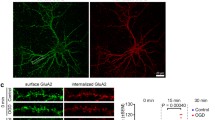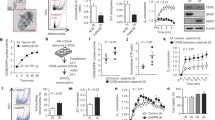Abstract
Cell death after stroke involves apoptotic, autophagocytic and necrotic mechanisms which may cause the release of cytosolic proteins to the extracellular space. Aldolase C (AldC) is the brain specific isoform of the glycolytic enzyme fructose-1,6-bisphosphate aldolase. According to its characteristic striped expression pattern in the adult cerebellum AldC is also termed zebrin II. Here, we demonstrate release of AldC into the cerebrospinal fluid (CSF) after stroke in vivo. Studies with cell cultures confirmed that AldC is released to the extracellular space after hypoxia. Moreover, addition of purified recombinant AldC to networks of cortical neurons plated on multielectrode arrays reversibly inhibited the spontaneous generation of action potentials at AldC concentrations which can be expected to occur after lesions of the human cerebral cortex. This mechanism could be relevant in the pathogenesis of the electrophysiological changes in the penumbra region after stroke.


Similar content being viewed by others
Abbreviations
- ABTS:
-
2,2′-Azino-bis(3-ethylbenzthiazoline-6-sulfonic acid)
- A.d.:
-
Aqua dest (H2O)
- AldA:
-
Aldolase A
- AldB:
-
Aldolase B
- AldC:
-
Aldolase C
- BSA:
-
Bovine serum albumin
- CSF:
-
Cerebrospinal fluid
- DTT:
-
Dithiothreitol
- ECL:
-
Enhanced chemiluminescence
- FBP:
-
Fructose-1,6-bisphosphate
- GAP:
-
Glycerinaldehyde-3-phosphate
- GDH:
-
Glycerol-3-phosphate-dehydrogenase
- IPTG:
-
Isopropyl-β-d-thiogalactopyranosid
- kDa:
-
kilo Dalton
- LB:
-
Luria Bertani
- MRI:
-
Magnetic resonance imaging
- PBS:
-
Phosphate buffered saline
- PMSF:
-
Phenyl methyl sulfonyl fluoride
- RT:
-
Room temperature
- SDS-PAGE:
-
Sodium dodecylsulfate-polyacrylamide gel electrophoresis
- TBS:
-
Tris buffered saline
- TIM:
-
Triose-phosphate-isomerase
- TTX:
-
Tetrodotoxin
- WB:
-
Western blot
References
Hossmann KA (1994) Glutamate-mediated injury in focal cerebral ischemia: the excitotoxin hypothesis revised. Brain Pathol 4:23–36
Markus HS (2004) Cerebral perfusion and stroke. J Neurol Neurosurg Psychiatry 75:353–361
Markus R, Donnan G, Kazui S, Read S, Reutens D (2004) Penumbral topography in human stroke: methodology and validation of the ‘Penumbragram’. Neuroimage 21:1252–1259
Blostein R, Rutter WJ (1963) Comparative studies of liver and muscle aldolase. II. Immunochemical and chromatographic differentiation. J Biol Chem 238:3280–3285
Rottmann WH, Deselms KR, Niclas J, Camerato T, Holman PS, Green CJ, Tolan DR (1987) The complete amino acid sequence of the human aldolase C isozyme derived from genomic clones. Biochimie 69:137–145
Lebherz HG, Rutter WJ (1969) Distribution of fructose diphosphate aldolase variants in biological systems. Biochemistry 8:109–121
Dalby AR, Tolan DR, Littlechild JA (2001) The structure of human liver fructose-1,6-bisphosphate aldolase. Acta Crystallogr D Biol Crystallogr 57:1526–1533
Seidenfeld J, Marton LJ (1979) Biochemical markers of central nervous system tumors measured in cerebrospinal fluid and their potential use in diagnosis and patient management: a review. J Natl Cancer Inst 63:919–931
Staugaitis SM, Zerlin M, Hawkes R, Levine JM, Goldman JE (2001) Aldolase C/zebrin II expression in the neonatal rat forebrain reveals cellular heterogeneity within the subventricular zone and early astrocyte differentiation. J Neurosci 21:6195–6205
Hawkes R, Herrup K (1995) Aldolase C/zebrin II and the regionalization of the cerebellum. J Mol Neurosci 6:147–158
Ahn AH, Dziennis S, Hawkes R, Herrup K (1994) The cloning of zebrin II reveals its identity with aldolase C. Development 120:2081–2090
Popovici T, Berwald-Netter Y, Vibert M, Kahn A, Skala H (1990) Localization of aldolase C mRNA in brain cells. FEBS Lett 268:189–193
Thompson RJ, Kynoch PA, Willson VJ (1982) Cellular localization of aldolase C subunits in human brain. Brain Res 232:489–493
Brochu G, Maler L, Hawkes R (1990) Zebrin II: a polypeptide antigen expressed selectively by Purkinje cells reveals compartments in rat and fish cerebellum. J Comp Neurol 291:538–552
Haimoto H, Kato K (1986) Highly sensitive enzyme immunoassay for human brain aldolase C. Clin Chim Acta 154:203–211
Florez G, Cabeza A, Gonzalez JM, Garcia J, Ucar S (1976) Changes in serum and cerebrospinal fluid enzyme activity after head injury. Acta Neurochir (Wien) 35:3–13
Dikow AL, Lolova I, Ivanova A, Bojinov S (1969) [Biochemical and histochemical studies of fructosephosphate aldolase in tumors of the nervous system. Isoenzymes of fructosephosphate aldolase. 8]. Z Klin Chem Klin Biochem 7:606–613
Sato S, Sugimura T, Chien TC, Takakura K (1971) Aldolase isozyme patterns of human brain tumors. Cancer 27:223–227
Ausubel FM (1987) Current protocols in molecular biology. Greene Publishing Associates, Brooklyn, NY
Rosslenbroich V, Dai L, Baader SL, Noegel AA, Gieselmann V, Kappler J (2005) Collapsin response mediator protein-4 regulates F-actin bundling. Exp Cell Res 310:434–444
Laemmli UK (1970) Cleavage of structural proteins during the assembly of the head of bacteriophage T4. Nature 227:680–685
Harlow E, Lane D (1988) Antibodies: a laboratory manual. Cold Spring Harbor Laboratory (ed), Cold Spring Harbor, NY
Rosslenbroich V, Dai L, Franken S, Gehrke M, Junghans U, Gieselmann V, Kappler J (2003) Subcellular localization of collapsin response mediator proteins to lipid rafts. Biochem Biophys Res Commun 305:392–399
Otto F, Goertz P, Fleischer W, Siebler M (2003) Cryopreserved rat cortical cells develop functional neuronal networks on microelectrode arrays. J Neurosci Methods 128:173–181
Ebert BL, Gleadle JM, O’Rourke JF, Bartlett SM, Poulton J, Ratcliffe PJ (1996) Isoenzyme-specific regulation of genes involved in energy metabolism by hypoxia: similarities with the regulation of erythropoietin. Biochem J 313:809–814
Gross GW, Rhoades BK, Azzazy HM, Wu MC (1995) The use of neuronal networks on multielectrode arrays as biosensors. Biosens Bioelectron 10:553–567
Nicholson C, Sykova E (1998) Extracellular space structure revealed by diffusion analysis. Trends Neurosci 21:207–215
Ta TV, Takano R, Kamei K, Xu XY, Kariya Y, Yoshida K, Hara S (1999) Fructose 1,6-bisphosphate aldolase is a heparin-binding protein. J Biochem (Tokyo) 125:554–559
Acknowledgments
We thank Norbert Rösel for excellent technical assistance and Prof. Richard Hawkes for the gift of the zebrin II antibody. This study was supported in part by the BMFZ of the Heinrich-Heine-University (Germany) and the Pinguin-Stiftung (Düsseldorf/Germany).
Author information
Authors and Affiliations
Corresponding author
Additional information
Stephanie Linke and Philipp Goertz contributed equally.
Electronic supplementary material
Rights and permissions
About this article
Cite this article
Linke, S., Goertz, P., Baader, S.L. et al. Aldolase C/Zebrin II is Released to the Extracellular Space after Stroke and Inhibits the Network Activity of Cortical Neurons. Neurochem Res 31, 1297–1303 (2006). https://doi.org/10.1007/s11064-006-9169-9
Received:
Accepted:
Published:
Issue Date:
DOI: https://doi.org/10.1007/s11064-006-9169-9




